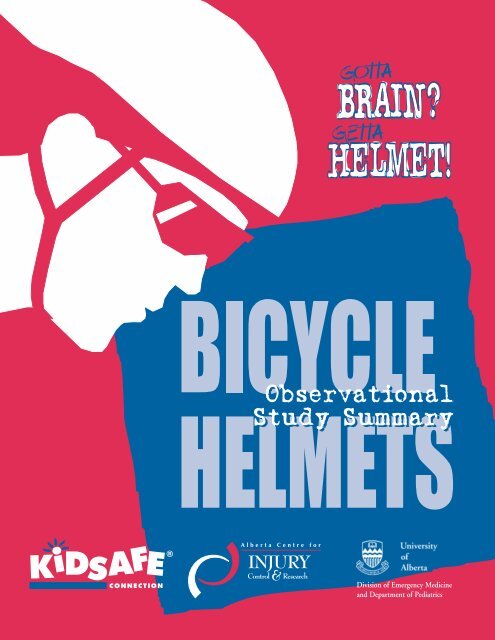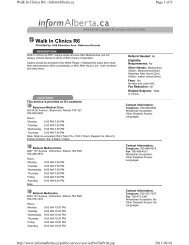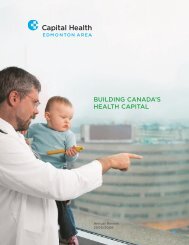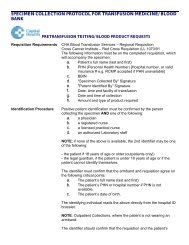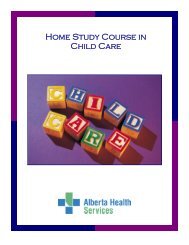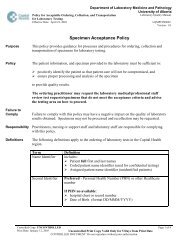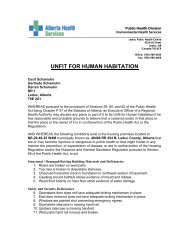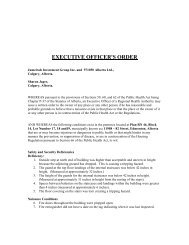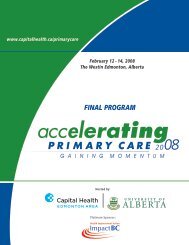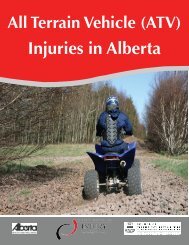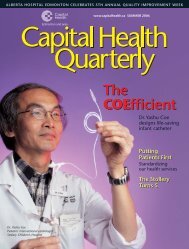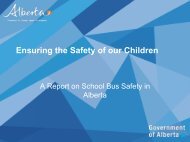Observational Study Summary - Capital Health
Observational Study Summary - Capital Health
Observational Study Summary - Capital Health
You also want an ePaper? Increase the reach of your titles
YUMPU automatically turns print PDFs into web optimized ePapers that Google loves.
<strong>Observational</strong><br />
<strong>Study</strong> <strong>Summary</strong><br />
Division of Emergency Medicine<br />
and Department of Pediatrics
In the summer of 2000, an observational survey was conducted in Alberta to gather<br />
information on bicycle helmet usage. Cyclists of all ages were observed in various locations<br />
(including schools, parks, designated cycling paths, residential areas, commuter routes, and<br />
campuses) and the results were recorded. Communities included in the survey were<br />
Calgary & surrounding area (Cochrane, Airdrie, and Okotoks); and Edmonton &<br />
surrounding area (Fort Saskatchewan, Leduc, Sherwood Park, St. Albert, and<br />
Spruce Grove).<br />
HEALTH CANADA<br />
Throughout this summary, the age groups are defined as: adults (≥ 18 years of age); adolescents (13 - 17 years of<br />
age); and children (≤12 years of age). Helmet usage was defined as any helmet worn by a cyclist.<br />
Alberta Sample Distribution<br />
Communities<br />
% of Alberta Population No. of Observations Helmet Usage<br />
Edmonton 23.0% 1,718 45%<br />
Calgary 29.9% 2,016 63%<br />
Edmonton Surrounding Area 5.6% 294 50%<br />
Calgary Surrounding Area 1.4% 113 64%<br />
59.9% 4,141 55%<br />
In Alberta, the overall helmet usage<br />
amongst observed cyclists (n=4,141) was<br />
55%.<br />
Age Group Age Group<br />
Observed Helmet Usage in Alberta by Age Groups<br />
Children<br />
Adolescents<br />
Adults<br />
0 10 20 30 40 50 60 70 80 90 100<br />
Helmet Usage in Alberta’s Major Urban Centres<br />
Children<br />
Adolescents<br />
Adults<br />
Percentage Wearing Helmets<br />
0 10 20 30 40 50 60 70 80 90 100<br />
Percentage Wearing Helmets<br />
Helmet Usage by Gender<br />
75% (n = 1,236)<br />
29% (n = 677)<br />
52% (n = 2,107)<br />
Calgary<br />
(& surrounding<br />
area)<br />
Edmonton<br />
(& surrounding<br />
area)<br />
87% 60%<br />
40% 20%<br />
55% 48%<br />
Adolescents (29%) have the lowest average<br />
bicycle helmet usage. Children (75%), are<br />
the most likely to wear a helmet.<br />
People in and around Calgary were more<br />
likely to wear a helmet than their<br />
counterparts in and around Edmonton.<br />
Overall, helmet usage for Calgary &<br />
surrounding area (n=2,129) was 63%.<br />
Overall, helmet usage observed for<br />
Edmonton & surrounding area (n=2,012)<br />
was significantly lower at 46%. Communities<br />
surrounding the two major urban centres<br />
were observed to have similar usage<br />
patterns as their closest major urban centre.<br />
Age Group<br />
Children<br />
Adolescents<br />
Adults<br />
Females Males<br />
80% 71%<br />
34% 27%<br />
63% 47%<br />
0 10 20 30 40 50 60 70 80 90 100<br />
Percentage Wearing Helmets<br />
Overall, helmet usage was higher for<br />
females (64%, n=1,204) than for males<br />
(50%; n=2,833). The higher percentage of<br />
helmet usage for females was consistent<br />
throughout all age groups.
Children are the<br />
most likely to<br />
wear a helmet<br />
Helmet Misuses (Among observed helmet users; n= 2,090)<br />
1% Wrong Type of Helmet<br />
4% Too Far Forward<br />
9% Straps Not Fastened Properly<br />
11% Too Far Back<br />
75% Correct Use<br />
Fifty-five percent of observed cyclists were<br />
wearing a helmet. Twenty-five percent of<br />
these were observed wearing their helmet<br />
incorrectly. While it appears that 75% of<br />
cyclists wearing helmets were wearing them<br />
correctly, this determination was obtained<br />
visually not manually.<br />
The most common misuse was the helmet<br />
sitting too far back on the head (11%)<br />
followed closely by straps not<br />
properly fastened (9%).<br />
Location<br />
School<br />
Park<br />
Cycling Path<br />
Residential<br />
Commuter Route<br />
Campus<br />
Helmet Usage by Location<br />
64% (n = 1,383)<br />
58% (n = 709)<br />
53% (n = 614)<br />
45% (n = 575)<br />
44% (n = 664)<br />
37% (n = 196)<br />
0 10 20 30 40 50 60 70 80 90 100<br />
Percentage Wearing Helmets<br />
Helmet usage was higher in areas that were<br />
more likely to be frequented by children,<br />
such as schools (64%).<br />
Companions<br />
Helmet Usage of Children By Companion Status<br />
With Adult(s)<br />
Helmet on at Least 1 Adult<br />
With Adult(s)<br />
No Helmet(s) on Adult(s)<br />
Without Adult(s)<br />
99%<br />
84%<br />
72%<br />
0 10 20 30 40 50 60 70 80 90 100<br />
Percentage of Children Wearing Helmets<br />
Riding with adults has a positive effect on<br />
helmet use by children. The percentage of<br />
children wearing helmets increases from<br />
72% when riding alone or with their peers,<br />
to 99% when riding with an adult who is<br />
wearing a helmet.
In Alberta, injuries are the leading cause of death for children,<br />
youth, & adults under 45 years of age.<br />
Bicycling is one of the most popular recreational activities with an estimated 85% of<br />
children (14 years & under) engaging in this activity.<br />
What we know…<br />
• In Alberta, bicycling injuries top the list of sport & recreational activities resulting in major trauma.<br />
• Over 6,000 Albertans are injured every year in bike-related incidents.<br />
• From April 1, 1997 – March 31, 1998: 2,548 children (aged 0-12); 1,286 youth (aged 13-17); and 2,596 adults (aged 18 and over)<br />
were seen in Alberta’s Emergency Departments for bike-related injuries.<br />
$ Bike-related injuries cost Canadians almost $200 million every year.<br />
• 82% of Alberta’s cyclists (19 years of age and under) who suffered a bike-related major trauma were not wearing a helmet at the time<br />
of the injury.<br />
• At least 45% of Albertans are not wearing bicycle helmets every time they ride, putting them at risk for brain injury. Many more may<br />
not be wearing their helmets correctly.<br />
• Currently, Alberta does not have bicycle helmet legislation that could protect its’ citizens from the serious long-term complications<br />
resulting from brain injury.<br />
Building a solution…<br />
• Scientific evidence clearly shows bike helmets reduce injury. They reduce the risk of suffering a bike-related upper & mid facial injury<br />
by 65% and brain injury by 88%.<br />
$ For every $1 spent on a bicycle helmet, $30 is saved on health care costs.<br />
• Studies show that combining educational efforts with legislation is the most effective means of influencing behavior change.<br />
Call to action…<br />
• Alberta needs a comprehensive educational campaign promoting bicycle helmet usage; and<br />
• Alberta needs comprehensive bike helmet legislation. Such legislation has potential to:<br />
• Decrease the number of head injuries suffered by Albertans;<br />
• Decrease the potential years of life lost by young Albertans;<br />
$ Decrease costs to Alberta’s health care system.<br />
Through partnerships, we can help ensure a healthy, active future for all Albertans.<br />
For more information, please contact:<br />
KIDSAFE Connection<br />
Stollery Children's <strong>Health</strong> Centre<br />
WMC 4H2.02, 8440 – 112 Street<br />
Edmonton, AB T6G 2B7<br />
(ph) 780 407 7250<br />
(fx) 780 407 6472<br />
KIDSAFE Connection<br />
Alberta Children's Hospital<br />
1820 Richmond Road SW<br />
Calgary, AB T2T 5C7<br />
(ph) 403 229 7833<br />
(fx) 403 541 7533<br />
Alberta Centre for Injury Control & Research<br />
4075 RTF University of Alberta<br />
8308 – 114 Street<br />
Edmonton, AB T6G 2E1<br />
(ph) 780 492 6019<br />
(fx) 780 492 7154<br />
This observational study was generously funded by a grant through the Alberta Centre for Injury Control & Research.


